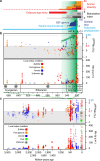Rise to modern levels of ocean oxygenation coincided with the Cambrian radiation of animals
- PMID: 25980960
- PMCID: PMC4479002
- DOI: 10.1038/ncomms8142
Rise to modern levels of ocean oxygenation coincided with the Cambrian radiation of animals
Abstract
The early diversification of animals (∼ 630 Ma), and their development into both motile and macroscopic forms (∼ 575-565 Ma), has been linked to stepwise increases in the oxygenation of Earth's surface environment. However, establishing such a linkage between oxygen and evolution for the later Cambrian 'explosion' (540-520 Ma) of new, energy-sapping body plans and behaviours has proved more elusive. Here we present new molybdenum isotope data, which demonstrate that the areal extent of oxygenated bottom waters increased in step with the early Cambrian bioradiation of animals and eukaryotic phytoplankton. Modern-like oxygen levels characterized the ocean at ∼ 521 Ma for the first time in Earth history. This marks the first establishment of a key environmental factor in modern-like ecosystems, where animals benefit from, and also contribute to, the 'homeostasis' of marine redox conditions.
Figures


References
-
- Erwin D. H. et al. The Cambrian conundrum: early divergence and later ecological success in the early history of animals. Science 334, 1091–1097 (2011). - PubMed
-
- Xiao S. & Laflamme M. On the eve of animal radiation: phylogeny, ecology and evolution of the Ediacara biota. Trends Ecol. Evol. 24, 31–40 (2009). - PubMed
-
- Knoll A. H. & Carroll S. B. Early animal evolution: emerging views from comparative biology and geology. Science 284, 2129–2137 (1999). - PubMed
-
- Mills D. B. & Canfield D. E. Oxygen and animal evolution: did a rise of atmospheric oxygen ‘trigger' the origin of animals? Bioessays 36, 1145–1155 (2014). - PubMed
Publication types
MeSH terms
Substances
LinkOut - more resources
Full Text Sources
Other Literature Sources

